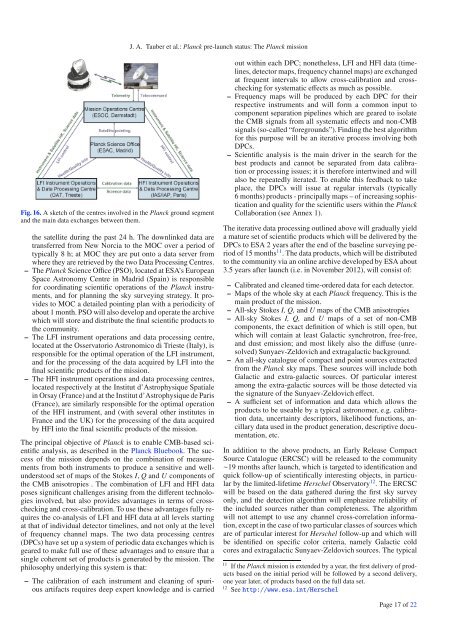Planck Pre-Launch Status Papers - APC - Université Paris Diderot ...
Planck Pre-Launch Status Papers - APC - Université Paris Diderot ...
Planck Pre-Launch Status Papers - APC - Université Paris Diderot ...
Create successful ePaper yourself
Turn your PDF publications into a flip-book with our unique Google optimized e-Paper software.
J. A. Tauber et al.: <strong>Planck</strong> pre-launch status: The <strong>Planck</strong> missionFig. 16. Asketchofthecentresinvolvedinthe<strong>Planck</strong> ground segmentand the main data exchanges between them.the satellite during the past 24 h. The downlinked data aretransferred from New Norcia to the MOC over a period oftypically 8 h; at MOC they are put onto a data server fromwhere they are retrieved by the two Data Processing Centres.– The <strong>Planck</strong> Science Office (PSO), located at ESA’s EuropeanSpace Astronomy Centre in Madrid (Spain) is responsiblefor coordinating scientific operations of the <strong>Planck</strong> instruments,and for planning the sky surveying strategy. It providesto MOC a detailed pointing plan with a periodicity ofabout 1 month. PSO will also develop and operate the archivewhich will store and distribute the final scientific products tothe community.– The LFI instrument operations and data processing centre,located at the Osservatorio Astronomico di Trieste (Italy), isresponsible for the optimal operation of the LFI instrument,and for the processing of the data acquired by LFI into thefinal scientific products of the mission.– The HFI instrument operations and data processing centres,located respectively at the Institut d’Astrophysique Spatialein Orsay (France) and at the Institut d’Astrophysique de <strong>Paris</strong>(France), are similarly responsible for the optimal operationof the HFI instrument, and (with several other institutes inFrance and the UK) for the processing of the data acquiredby HFI into the final scientific products of the mission.The principal objective of <strong>Planck</strong> is to enable CMB-based scientificanalysis, as described in the <strong>Planck</strong> Bluebook. Thesuccessof the mission depends on the combination of measurementsfrom both instruments to produce a sensitive and wellunderstoodset of maps of the Stokes I, Q and U components ofthe CMB anisotropies . The combination of LFI and HFI dataposes significant challenges arising from the different technologiesinvolved, but also provides advantages in terms of crosscheckingand cross-calibration. To use these advantages fully requiresthe co-analysis of LFI and HFI data at all levels startingat that of individual detector timelines, and not only at the levelof frequency channel maps. The two data processing centres(DPCs) have set up a system of periodic data exchanges which isgeared to make full use of these advantages and to ensure that asingle coherent set of products is generated by the mission. Thephilosophy underlying this system is that:– The calibration of each instrument and cleaning of spuriousartifacts requires deep expert knowledge and is carriedout within each DPC; nonetheless, LFI and HFI data (timelines,detector maps, frequency channel maps) are exchangedat frequent intervals to allow cross-calibration and crosscheckingfor systematic effects as much as possible.– Frequency maps will be produced by each DPC for theirrespective instruments and will form a common input tocomponent separation pipelines which are geared to isolatethe CMB signals from all systematic effects and non-CMBsignals (so-called “foregrounds”). Finding the best algorithmfor this purpose will be an iterative process involving bothDPCs.– Scientific analysis is the main driver in the search for thebest products and cannot be separated from data calibrationor processing issues; it is therefore intertwined and willalso be repeatedly iterated. To enable this feedback to takeplace, the DPCs will issue at regular intervals (typically6months)products-principallymaps–ofincreasingsophisticationand quality for the scientific users within the <strong>Planck</strong>Collaboration (see Annex 1).The iterative data processing outlined above will gradually yieldamaturesetofscientificproductswhichwillbedeliveredbytheDPCs to ESA 2 years after the end of the baseline surveying periodof 15 months 11 .Thedataproducts,whichwillbedistributedto the community via an online archive developed by ESA about3.5 years after launch (i.e. in November 2012), will consist of:– Calibrated and cleaned time-ordered data for each detector.– Maps of the whole sky at each <strong>Planck</strong> frequency. This is themain product of the mission.– All-sky Stokes I, Q, and U maps of the CMB anisotropies– All-sky Stokes I, Q, and U maps of a set of non-CMBcomponents, the exact definition of which is still open, butwhich will contain at least Galactic synchrotron, free-free,and dust emission; and most likely also the diffuse (unresolved)Sunyaev-Zeldovich and extragalactic background.– An all-sky catalogue of compact and point sources extractedfrom the <strong>Planck</strong> sky maps. These sources will include bothGalactic and extra-galactic sources. Of particular interestamong the extra-galactic sources will be those detected viathe signature of the Sunyaev-Zeldovich effect.– Asufficient set of information and data which allows theproducts to be useable by a typical astronomer, e.g. calibrationdata, uncertainty descriptors, likelihood functions, ancillarydata used in the product generation, descriptive documentation,etc.In addition to the above products, an Early Release CompactSource Catalogue (ERCSC) will be released to the community∼19 months after launch, which is targeted to identification andquick follow-up of scientifically interesting objects, in particularby the limited-lifetime Herschel Observatory 12 .TheERCSCwill be based on the data gathered during the first sky surveyonly, and the detection algorithm will emphasize reliability ofthe included sources rather than completeness. The algorithmwill not attempt to use any channel cross-correlation information,except in the case of two particular classes of sources whichare of particular interest for Herschel follow-up and which willbe identified on specific color criteria, namely Galactic coldcores and extragalactic Sunyaev-Zeldovich sources. The typical11 If the <strong>Planck</strong> mission is extended by a year, the first delivery of productsbased on the initial period will be followed by a second delivery,one year later, of products based on the full data set.12 See http://www.esa.int/HerschelPage 17 of 22
















